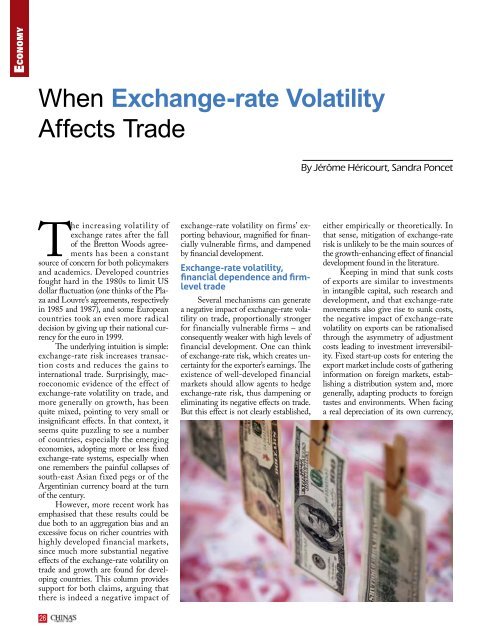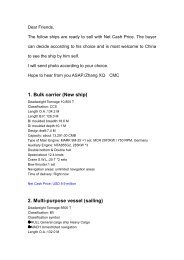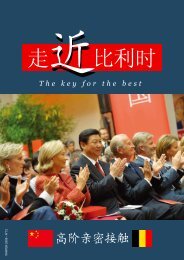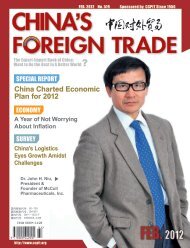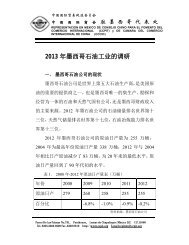Create successful ePaper yourself
Turn your PDF publications into a flip-book with our unique Google optimized e-Paper software.
ECONOMY<br />
When Exchange-rate Volatility<br />
Affects Trade<br />
By Jérôme Héricourt, Sandra Poncet<br />
The increasing volatility of<br />
exchange rates after the fall<br />
of the Bretton Woods agreements<br />
has been a constant<br />
source of concern for both policymakers<br />
and academics. Developed countries<br />
fought hard in the 1980s to limit US<br />
dollar fluctuation (one thinks of the Plaza<br />
and Louvre’s agreements, respectively<br />
in 1985 and 1987), and some European<br />
countries took an even more radical<br />
decision by giving up their national currency<br />
for the euro in 1999.<br />
The underlying intuition is simple:<br />
exchange-rate risk increases transaction<br />
costs and reduces the gains to<br />
international trade. Surprisingly, macroeconomic<br />
evidence of the effect of<br />
exchange-rate volatility on trade, and<br />
more generally on growth, has been<br />
quite mixed, pointing to very small or<br />
insignificant effects. In that context, it<br />
seems quite puzzling to see a number<br />
of countries, especially the emerging<br />
economies, adopting more or less fixed<br />
exchange-rate systems, especially when<br />
one remembers the painful collapses of<br />
south-east Asian fixed pegs or of the<br />
Argentinian currency board at the turn<br />
of the century.<br />
However, more recent work has<br />
emphasised that these results could be<br />
due both to an aggregation bias and an<br />
excessive focus on richer countries with<br />
highly developed financial markets,<br />
since much more substantial negative<br />
effects of the exchange-rate volatility on<br />
trade and growth are found for developing<br />
countries. This column provides<br />
support for both claims, arguing that<br />
there is indeed a negative impact of<br />
26<br />
exchange-rate volatility on firms’ exporting<br />
behaviour, magnified for financially<br />
vulnerable firms, and dampened<br />
by financial development.<br />
Exchange-rate volatility,<br />
financial dependence and firmlevel<br />
trade<br />
Several mechanisms can generate<br />
a negative impact of exchange-rate volatility<br />
on trade, proportionally stronger<br />
for financially vulnerable firms – and<br />
consequently weaker with high levels of<br />
financial development. One can think<br />
of exchange-rate risk, which creates uncertainty<br />
for the exporter’s earnings. The<br />
existence of well-developed financial<br />
markets should allow agents to hedge<br />
exchange-rate risk, thus dampening or<br />
eliminating its negative effects on trade.<br />
But this effect is not clearly established,<br />
either empirically or theoretically. In<br />
that sense, mitigation of exchange-rate<br />
risk is unlikely to be the main sources of<br />
the growth-enhancing effect of financial<br />
development found in the literature.<br />
Keeping in mind that sunk costs<br />
of exports are similar to investments<br />
in intangible capital, such research and<br />
development, and that exchange-rate<br />
movements also give rise to sunk costs,<br />
the negative impact of exchange-rate<br />
volatility on exports can be rationalised<br />
through the asymmetry of adjustment<br />
costs leading to investment irreversibility.<br />
Fixed start-up costs for entering the<br />
export market include costs of gathering<br />
information on foreign markets, establishing<br />
a distribution system and, more<br />
generally, adapting products to foreign<br />
tastes and environments. When facing<br />
a real depreciation of its own currency,


